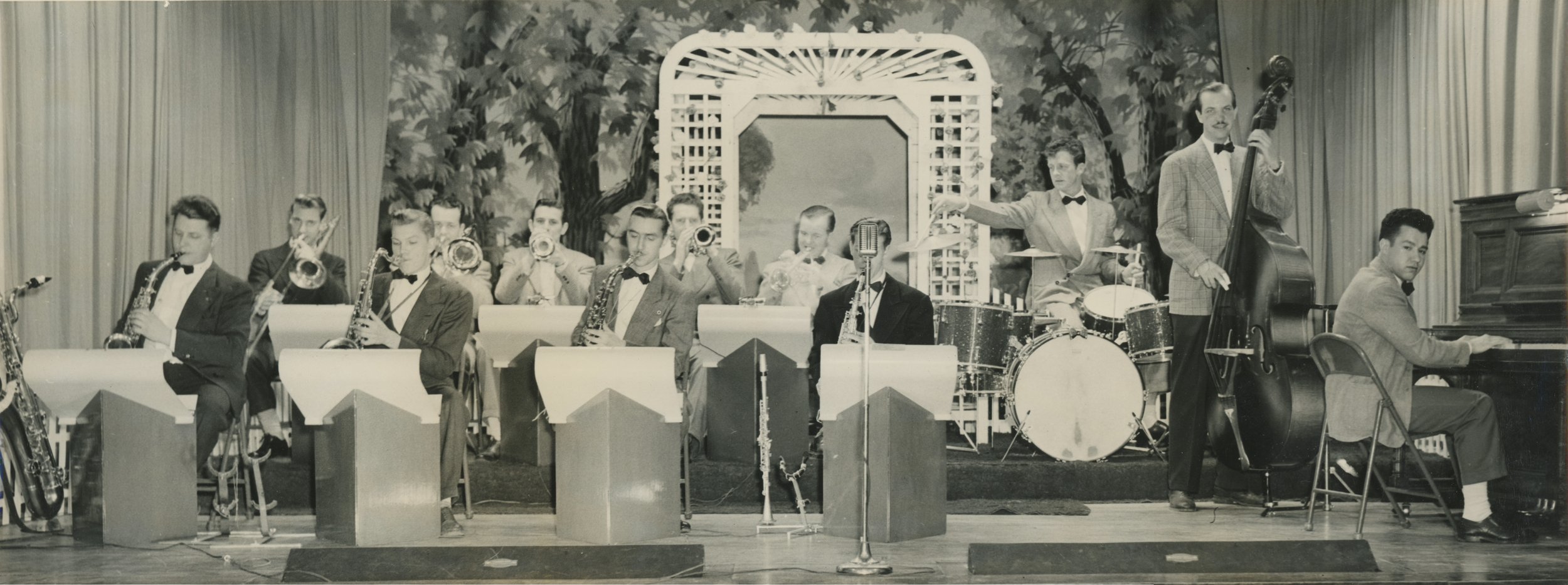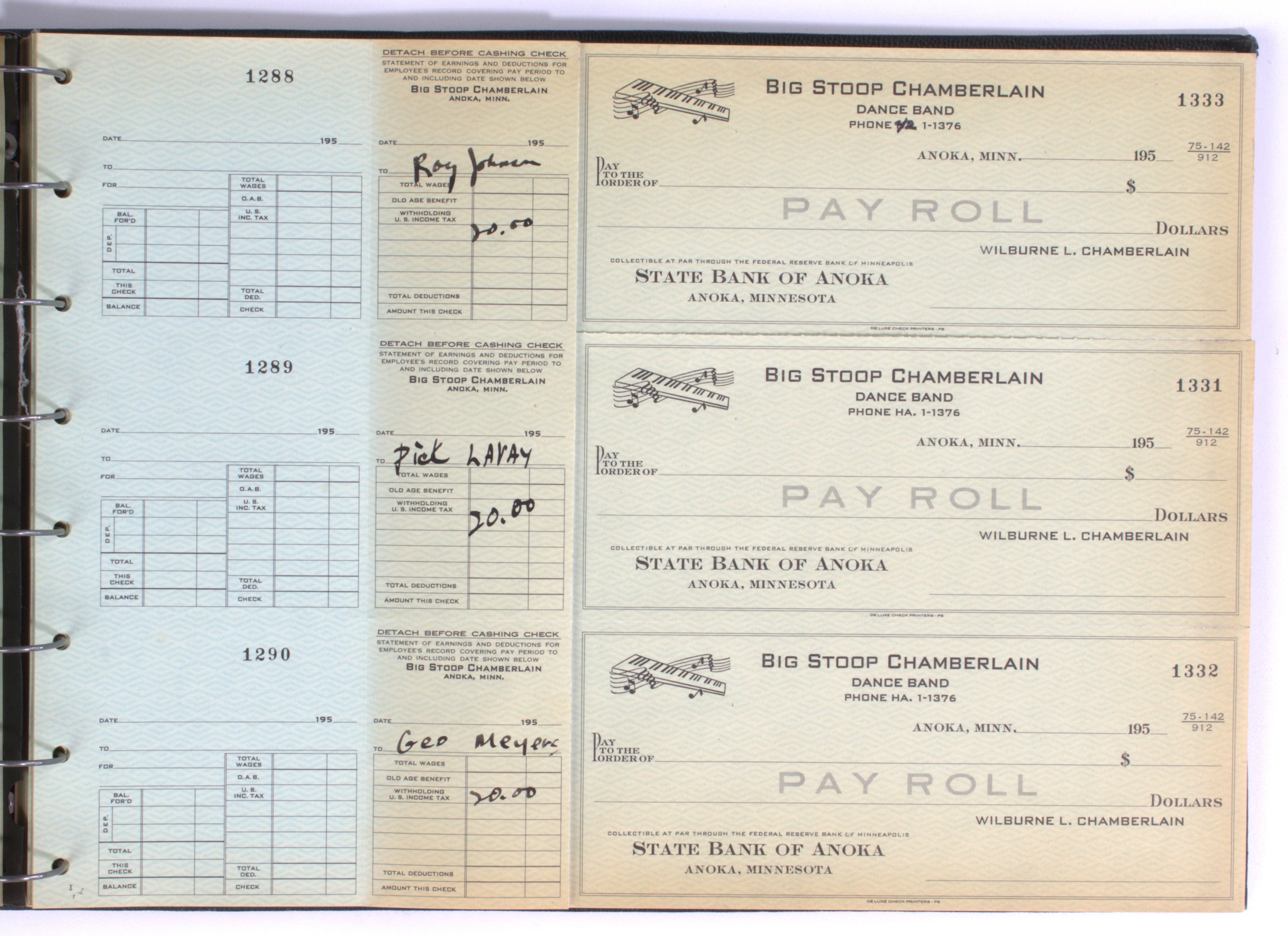History 21 The Podcast - 2.07 Big Stoop Orchestra
The Big Stoop Orchestra played to a crowd of 600 at Anoka High School on January 28, 1948. In this special episode, hear the story of how Wilburne “Big Stoop” Chamberlain started the band in 1946, the band’s time at Oak Ridge Resort on Crooked Lake, as well as listen to music the band played at that concert in 1948. Special thanks to Mark Joslyn and podcast guest Ron Chamberlain.
Hosts Sara Given, ACHS Volunteer Coordinator and Rebecca Ebnet-Desens, ACHS Executive Director.
The Big Stoop Orchestra at a March of Dimes benefit concert held at Anoka High School January 28, 1948. Band members identified as: Big Stoop is Wilburne Chamberlain and is the Base Player. Tom Ward is playing drums. Row 1: Roger Erickson, Warren Jocelyn, John Bravis, Dick Chamberlain Row 2: ?, ?, Bob Gruenfelder?, George Heileman, Winslow Chamberlain
The Trumpet II music for “Moon River” by Henry Mancini arranged by Wilburne “Big Stoop” Chamberlain sometime after the pieces’ appearance in the movie “Breakfast at Tiffany’s” 1961. When Wilburne decided not to play the piece anymore he added a large red squiggle down the page, and arranged a different piece on the back of the paper.
Big Stoop Orchestra
Founded in 1946 by Wilburne “Big Stoop” Chamberlain after his return from WWII, the original band was made up of friends and musicians around Anoka. The band played locally at Oak Ridge Resort through the late 40s and early 50s. Later, their popularity and musical skill saw them shifting to play ballrooms in Minneapolis and St. Paul.
The band has continued to play through shifts in musical tastes, changes in membership and leadership, and their namesakes death. After 76 years, the band plays on and can be found playing at events, weddings, and festivals that bring them joy.
Vault Extras
Full Interview with Ron Chamberlain talking about his father’s band, The Big Stoop Orchestra, and how it transformed into the current-day Big Stoop Orchestra.
Vault members can listen to all eight pieces from The Big Stoop Orchestra that are digitized in the ACHS Collection.
Playlist:
1. "Four Leaf Clover" W. Chamberlain. Jan 28, 1948
2. "My Reverie" with Jimmie Stevens and W. Chamberlain. Jan 28, 1948
3. "Laura" W. Chamberlain. Jan 28, 1948.
4. "Theme - Opus #1" W Chamberlain. Jan 28, 1948.
5. "She's Funny That Way" W. Chamberlain. Jan 28, 1948.
6. "Choo Choo Ch'Boogie" with Tom Ward and W. Chamberlain. Jan 28, 1948.
7. "Tom Ward Boogie" Undated.
8. Unidentified piece, undated.
Label on one of The Big Stoop Orchestra’s records.
March of Dimes Fundraiser
The Big Stoop Orchestra donated their services to the concert held on January 28, 1948. The concert was advertised as “the first all popular music concert ever to be presented in Anoka” and was part of a series of events to raise money for the March of Dimes. The campaign coincided with the 10th anniversary of the national foundation for infantile paralysis also known as polio.
Concert recap printed in the Anoka Union Jan. 30, 1948:
“Large crowd at music Benefit. 600 attend concert at Anoka high school. Over six hundred people gathered at the Anoka high school auditorium Wednesday evening to hear “Big Stoop” Chamberlain and his orchestra present a concert “Contrasts in Music” for the benefit o the March of Dimes. Misses Peggy Ward, Marjean Vick and James Stevens of Minneapolis were accompanying vocalists. Winslow Chamberlain conducted the orchestra while Wilburne Chamberlain was master of ceremonies.”
“A Critique” of the concert printed in the Anoka Union Jan. 30, 1948:
“Making the first concert appearance in its existence, Big Stoop Chamberlains orchestra definitely pleased over 600 persons who gathered at the high school Wednesday evening. The 12 piece orchestra really put on a show and lived up to its reputation as a “name” band. The lighting effects were done by the Ugly Ducklings Inc. an Anoka organization.
The orchestra featured sweet, boogie-woogie, and jazz numbers with most of the arrangements written by “Big Stoop” himself. Two numbers “Confusion” and “Bent Lake Shuffle” were original compositions by the tall Chamberlain boy.
Wilburne Chamberlain has really built up an excellent organization composed of excellent musicians. “Big Stoop” handles the bass while brother Winslow turns on the old personality in doing a bang up job of conducting and solo trumpeting.
Tom Ward, the orchesta’s drummer, stole the show on several occasions with his acting and his husky rapid-fire singing. The boys put on the “Four Leaf Clover” in top style.
The members of the orchestra were all featured during the program and include besides the three named: Joseph Shifferli, Carl Ogden, Doug Turnquist, trumpeters; Harry Anderson, the trombone; Forest Medin, Warren Joslyn, John Bravis and Jack Furney saxophonists, and Bob Benholkin pianist.
Miss Peggy Ward sang “Jalousie” responding to an encore. Miss Marjean Vick sand “Tangerine” and also responded to an encore. Jimmie Stevens of Minneapolis appeared as guest soloist singing three numbers. The vocals were seriously hampered by the failure of the loud speaking system.
The musicians donated their services and the building was rent free with all proceeds going to the March of Dimes. Mrs. Robert Cochran was in charge. Loren Soderstrom spoke briefly during the intermission appearing in place of Morris Bye, who was confined to his home by illness. Loren thanked the group and urged support of the March of Dimes program.
It was a good show, excellently handled and well presented by a fine group of musicians.”
Part of a page in Wilburne Chamberlain’s ledger where he kept track of the dates the orchestra played, and the money collected and then distributed to the musicians.
Oak Ridge Resort after a fire in 1958.
The Big Stoop Orchestra’s book of checks issued by the State Bank of Anoka.
Anoka County Library Minute
Further Reading:
Blue Note Records: beyond the notes by Sophie Huber (DVD781.65 BLU)
Blue Note Records is a jazz label with over 8 decades of experience producing music from the likes of seasoned veterans such as Herbie Hancock to modern jazz-makers like Norah Jones. This music documentary tracks the history not only of the record label itself, but the historical context in which it was operating under.
Big Band Holidays I and II produced by Wynton Marsalis (CD782.281723 MAR)
If it’s never too early for you to listen to holiday music, check out these music CDs featuring big band renditions of all your holiday favorites from Jingle Bells to White Christmas.
United We Swing: best of the Jazz at Lincoln Center galas by Wynton Marsalis (CD781.65 WYN)
The Wynton Marsalis Septet takes on a number of tunes with the likes of Bob Dylan, Lenny Kravitz, Ray Charles - all performed live. The main thrust of the project is to highlight the importance of jazz in American cultural heritage while also proving that music has the power to unite us.
How to Dance by Rob Glover (DVD793.3 HOW)
Listening to big band music is one thing, but dancing to it is quite another. This DVD will show you how to dance to various styles of swing dance, including the Lindy Hop. Other dance styles covered include various Latin rhythms, ballroom dance, and country dance.
Jazz DVD series by Ken Burns (DVD 781.65 JAZ)
Ken Burns delivers a 10-part DVD documentary on the history of Jazz - from its birth in New Orleans in the late 1800s, to the early 1960s, which ushers in the age of rock’n’roll, and everything in between.
Jazz Standards from the Hal Leonard Essential Songs Series (Q 781.65 JAZ)
This resource is a songbook containing sheet music for voice, piano and guitar focusing on popular jazz songs. There are over 90 songs included.
The Best Big Band Songs Ever from Hal Leonard Publishing (Q 781.654 BES)
This resource is a songbook containing sheet music for voice, piano and guitar focusing on big band music. There are over 60 songs included.
Why Jazz?: a concise guide by Kevin Whitehead (781.65 WHI)
As a long-time jazz critic for NPR, Whitehead offers a short yet rich introduction to the history of jazz music. Chapters are broken down into time frames within the musical movement. The author also includes profiles of jazz’s most influential contributors.
The Jazz Standards: a guide to the repertoire by Ted Gioia (781.65 GIO)
In this book, the author offers up what he considers to be the most influential songs in the jazz genre and he not only gives the story of how the song came to be, but also recommends various versions of the song performed by other artists.
Mama Mable’s All-Gal Big Band Jazz Extravaganza! by Annie Sieg (E SIE)
This vibrantly illustrated children’s picture book tells the story of a fictional, all-women big band that comes to a town needing a little pick-me up during the onset of WWII. The town of mostly women and children have been doing their part at home in the war effort, but find respite in the band’s arrival. The women of the band are all fictional but loosely based on real life musicians of the time. This book would be a good introduction to the music style as well as the time period.
Discover kits are starter kits of materials you need to engage with a new hobby.
Kits which may be of particular interest to listeners of this episode might be the “Learn to Play Drums” kit or the “Learn to Play Piano” kit. You’ll have the makings of a big band in no time!








